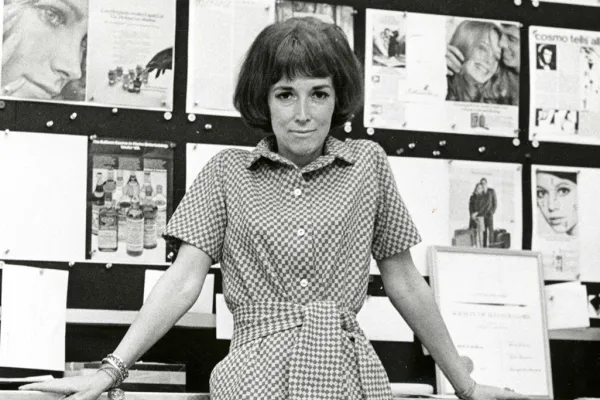Brooke Hauser: Five Secrets I Learned About Helen Gurley Brown From the Smith Archives
Research & Inquiry

Published November 6, 2015
Author, journalist and Smith lecturer Brooke Hauser spent countless hours in the college’s Sophia Smith Collection doing research for her new book on the late magazine editor Helen Gurley Brown, whose papers are part of Smith’s extensive women’s history archives.
Brown, author of the groundbreaking bestseller Sex and the Single Girl, was also the pioneering editor-in-chief of Cosmopolitan magazine from the 1960s to the 1990s.
Hauser’s new book—which will be published in April 2016—draws on new interviews with Brown’s friends and colleagues, as well as letters and other personal documents from the archives.
Hauser will give a talk about her book Monday, Nov. 9, at 7:30 p.m., in Neilson Browsing Room. Sponsored by the Friends of the Smith College Libraries, the event will offer a fresh glimpse into Brown’s life and legacy.
For a quick preview, here are five secrets Hauser says she learned about Brown from the Smith archives. (“Don’t worry,” Hauser says. “I have plenty more” to share on Nov. 9.)
- Helen Gurley Brown didn’t come up with the idea for her groundbreaking 1962 book, Sex and the Single Girl. Her husband, David Brown, did. A story editor for 20th Century Fox, David Brown went on to become a legendary movie producer (The Sting, Jaws), but Helen Gurley Brown may have been his most successful production of all. In 1965, she became the editor-in-chief of Cosmopolitan, then a failing general-interest magazine, after submitting a proposal for a new publication, Femme, aimed at single women. Femme was the blueprint for the “the new Cosmo” that Brown helped create, and if you hurry over to the Sophia Smith Collection, it will be the best thing you’ll read all day.
- Second-wave feminists accused Helen Gurley Brown of treating women as sex objects, but she gave men the same treatment as early as 1972, when she featured Burt Reynolds as Cosmo’s first male nude centerfold. Brown had been flirting with the idea of a “Cosmopolitan nude man” ever since the late-1960s, but it took her a while to find a major star willing to go full monty in a national magazine. Paul Newman, Robert Redford, Warren Beatty and Dustin Hoffman all said ‘no’ before Reynolds said ‘yes.’ Check out the original foldout of this brave man on a bearskin rug, with his hairy chest and dangling cigarillo. (He’s posing with a cigarillo.)
- Everybody knows that Helen Gurley Brown loved men, but she also fantasized about women—and not just the busty bombshells who regularly graced the covers of Cosmo. In an early draft of her 1964 book, Sex and the Office, Brown wrote a series of vignettes, “Three Little Bedtime Stories,” which included a steamy sex scene between two women—a young model and a sophisticated older designer. The erotic tale never made it into the book (Brown’s publisher feared it would ruin the author’s reputation), but it’s here in the Smith archives, along with Brown’s letters on the subject of lesbians, which she chronically misspelled “lesbions.”
- Brown’s rags-to-riches story is not exactly accurate. In her writings, she often cast herself as a poor little girl from Arkansas who made good, despite the odds against her. But growing up in Little Rock, Brown’s family was middle-class. After her father died when she was 10 and her sister was diagnosed with polio, everything changed. The family moved to Los Angeles, where they struggled. Brown was obsessed with money her whole life, even after she became rich. She was also obsessed about her weight, declaring that “skinny is sacred.” Among her files in the archives are meticulous financial records and expense receipts, as well as lists of her measurements and clothing expenditures.
- Helen Gurley Brown greatly admired Gloria Steinem ’56—and Steinem’s alma mater.While they didn’t always see eye-to-eye, Brown and Steinem were allies, not enemies. They wrote letters back and forth over the years, and Brown came to rely on Steinem as a guide to what was happening in the women’s movement. Steinem frequently signed her letters, “In Sisterhood.” Years later, the two women’s respective archives—both housed in the Sophia Smith Collection—seem to be talking to each other. As a young woman, Brown didn’t have the means to attend a formal college (she went to secretarial school), but in her later years, she felt a strong connection to Smith. Donating her papers here, she said, “I feel I have a home.”
Helen Gurley Brown, Sophia Smith Collection, Smith College Archives